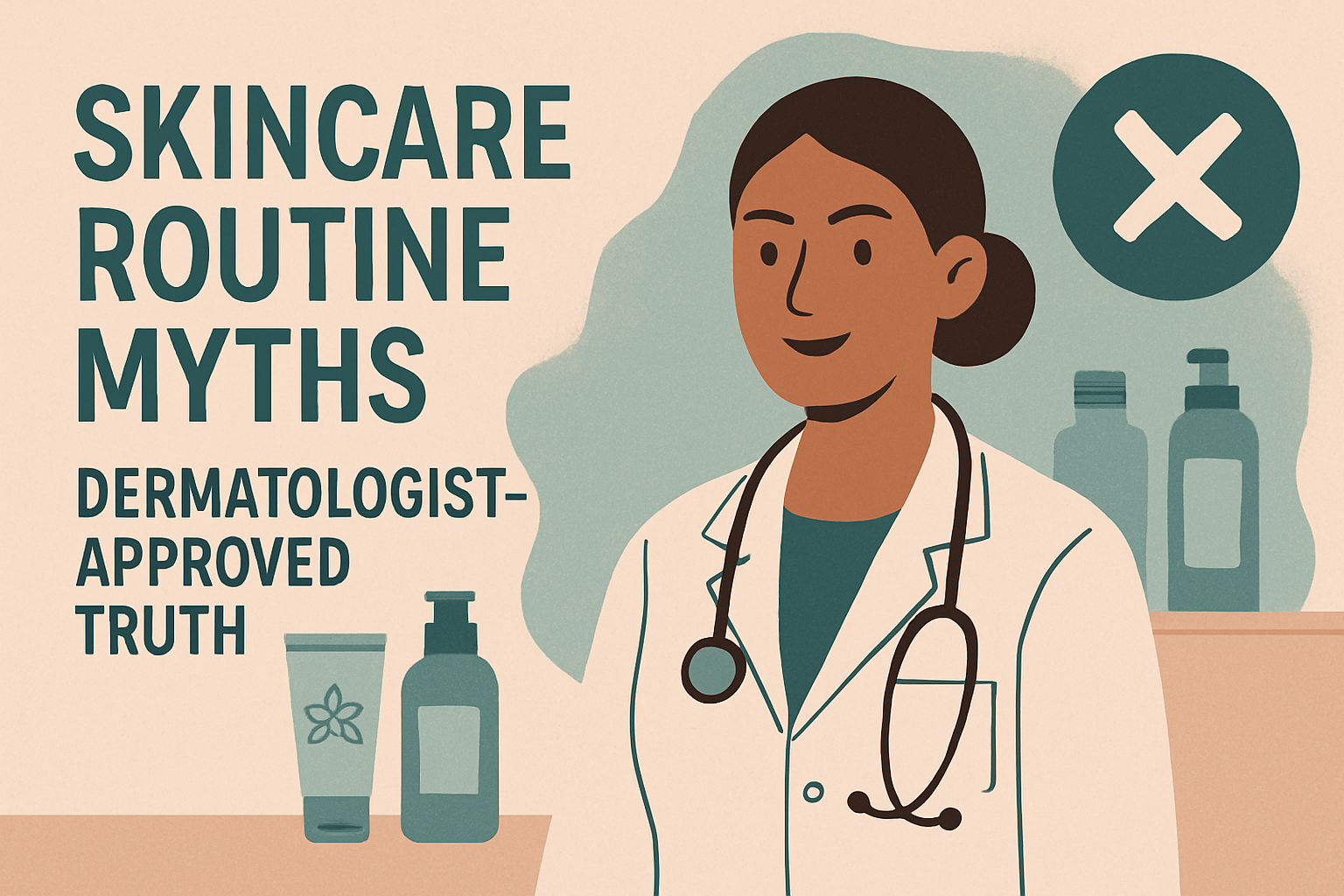Skincare Routine Myths: Dermatologist-Approved Truth

In the ever-evolving world of beauty and wellness, skincare routine myths have proliferated across social media platforms, beauty magazines, and even well-meaning advice from friends and family. These misconceptions about proper skincare practices can range from harmless old wives’ tales to potentially damaging beliefs that may compromise your skin’s health and appearance. With the global skincare industry valued at over $180 billion and countless products promising miraculous results, it’s no wonder that separating fact from fiction has become increasingly challenging for consumers seeking effective dermatological care.
The proliferation of beauty misconceptions has been amplified by the rise of influencer culture and viral beauty trends that often prioritize aesthetics over science. Many individuals unknowingly follow ineffective skincare habits based on outdated information or marketing claims that lack scientific backing. These myths not only waste time and money but can also lead to skin irritation, premature aging, and exacerbation of existing skin conditions. Understanding the truth behind these common misconceptions is crucial for developing an effective, evidence-based skincare regimen that actually delivers results.
This comprehensive guide aims to debunk the most persistent skincare routine myths by presenting dermatologist-approved facts backed by scientific research. We’ll explore why certain beliefs have become so widespread, examine the actual science behind skin health maintenance, and provide practical alternatives based on what dermatologists actually recommend. Whether you’re dealing with acne, aging concerns, or simply want to optimize your daily routine, this article will equip you with the knowledge needed to make informed decisions about your facial care routine and overall skin health.
EXPLORE THE CONTENTS
The Most Common Skincare Routine Myths Debunked
Myth 1: You Need Expensive Products for Effective Skincare
One of the most pervasive skincare routine myths suggests that price directly correlates with product effectiveness. This misconception has led countless consumers to believe that luxury skincare brands inherently offer superior results compared to their drugstore counterparts. However, dermatologists consistently emphasize that effective skincare ingredients can be found across all price points, and what matters most is the formulation and concentration of active ingredients rather than the price tag.
The truth is that many affordable products contain the same scientifically proven ingredients as their high-end alternatives. Key compounds like retinoids, niacinamide, hyaluronic acid, and vitamin C are available in both budget-friendly and luxury formulations. The difference often lies in packaging, marketing, and additional ingredients that may enhance the sensory experience but don’t necessarily improve efficacy. Dermatologists recommend focusing on ingredient lists and choosing products based on your specific skin type and concerns rather than being swayed by prestigious brand names or hefty price tags.
Furthermore, some of the most effective dermatologist-recommended products are surprisingly affordable. Petroleum jelly, for instance, remains one of the most effective occlusive moisturizers available, despite costing just a few dollars. Similarly, many drugstore sunscreens provide excellent broad-spectrum protection comparable to designer alternatives. The key to building an effective routine lies in understanding which ingredients address your specific concerns and finding well-formulated products that deliver these actives effectively, regardless of their price point.
Myth 2: Natural and Organic Always Means Better
The belief that natural or organic skincare products are inherently superior to synthetic alternatives represents another widespread skincare misconception. While the clean beauty movement has raised awareness about potentially harmful ingredients, the assumption that “natural equals safe” can be misleading and potentially dangerous. Many natural substances can cause severe allergic reactions, irritation, or photosensitivity, while numerous synthetic ingredients have extensive safety data supporting their use in cosmetic formulations.
Poison ivy is natural, but you wouldn’t want it in your face cream. Similarly, essential oils like lavender, tea tree, and citrus oils, despite their natural origins, are common causes of contact dermatitis and allergic reactions. These botanical ingredients can be particularly problematic for individuals with sensitive skin or existing skin conditions. Conversely, many synthetic ingredients have been specifically designed to be more stable, less irritating, and more effective than their natural counterparts. Laboratory-created peptides, for example, can provide targeted anti-aging benefits with minimal risk of irritation.
Dermatologists advocate for a balanced approach that evaluates ingredients based on scientific evidence rather than their origin. The most effective skincare formulations often combine both natural and synthetic ingredients to maximize benefits while minimizing potential adverse reactions. What matters most is whether an ingredient has been proven safe and effective through rigorous testing, not whether it came from a plant or a laboratory. When selecting products, focus on finding formulations that work for your skin type and address your specific concerns, regardless of whether they’re labeled as natural, organic, or synthetic.
Also Read: The Rise of AI in Beauty &; Skincare in 2025
Cleansing Myths That Could Damage Your Skin
Myth 3: You Should Wash Your Face Until It Feels “Squeaky Clean”
The sensation of “squeaky clean” skin after washing has long been associated with thorough cleansing, but this skincare routine myth can actually indicate over-cleansing and damage to your skin’s protective barrier. That tight, dry feeling many people associate with cleanliness is actually a sign that you’ve stripped away not just dirt and excess oil, but also the essential lipids and natural moisturizing factors that keep your skin barrier function intact and healthy.
Your skin’s natural pH hovers around 5.5, making it slightly acidic, which helps protect against harmful bacteria and maintain optimal barrier function. Harsh cleansers that create that squeaky-clean feeling often have a high pH that disrupts this delicate balance, leading to increased water loss, sensitivity, and paradoxically, increased oil production as your skin tries to compensate for the moisture loss. This cycle of over-cleansing and oil overproduction can exacerbate various skin conditions including acne, rosacea, and eczema.
Dermatologists recommend using gentle, pH-balanced cleansers that effectively remove dirt, makeup, and excess oil without compromising your skin’s natural protective mechanisms. After cleansing, your skin should feel clean but still comfortable and slightly hydrated, never tight or dry. If you experience that squeaky-clean sensation, it’s a sign to switch to a gentler facial cleanser that respects your skin’s natural balance. Remember, the goal of cleansing is to remove impurities while maintaining the integrity of your skin barrier, not to strip it completely.
Myth 4: Hot Water Opens Pores and Cold Water Closes Them
The idea that pores can open and close like doors based on water temperature is one of the most enduring beauty myths in skincare. Pores don’t have muscles that allow them to open or close; they’re simply openings in the skin where hair follicles and sebaceous glands are located. While temperature can affect the appearance of pores and the behavior of sebum, the fundamental structure of your pores remains unchanged regardless of whether you use hot or cold water.
What actually happens when you use hot water is that heat can soften the sebum (oil) within pores, making it easier to cleanse away impurities. However, excessively hot water can also strip your skin of natural oils, damage capillaries, and exacerbate conditions like rosacea. Cold water, on the other hand, can temporarily cause blood vessels to constrict, which might make pores appear slightly smaller, but this effect is fleeting and doesn’t actually change pore size. Neither temperature provides any lasting benefit in terms of pore size reduction.
Dermatologists recommend using lukewarm water for facial cleansing as it’s gentle on the skin while still being effective at removing dirt and oil. This temperature won’t cause the irritation and dryness associated with hot water, nor will it make cleansing products less effective as very cold water might. If you’re concerned about the appearance of large pores, focus on ingredients that can actually make a difference, such as retinoids, niacinamide, and salicylic acid, which help regulate oil production and improve skin texture over time. These evidence-based treatments are far more effective than temperature manipulation for achieving smoother, more refined-looking skin.
Anti-Aging Misconceptions
Myth 5: Anti-Aging Products Are Only for Mature Skin
One of the most limiting skincare routine myths is the belief that anti-aging products should only be used once visible signs of aging appear. This reactive approach to skincare overlooks the fundamental principle that prevention is far more effective than correction when it comes to maintaining youthful, healthy skin. Dermatologists emphasize that many ingredients marketed as “anti-aging” actually work best when incorporated into your preventive skincare routine during your twenties and thirties, before significant damage occurs.
The process of skin aging begins much earlier than most people realize, with collagen production starting to decline as early as our mid-twenties. Environmental factors like UV exposure, pollution, and lifestyle choices continuously contribute to premature skin aging through oxidative stress and inflammation. By waiting until wrinkles, dark spots, and sagging become visible, you’re essentially trying to reverse years of accumulated damage rather than preventing it from occurring in the first place. Starting a comprehensive anti-aging skincare regimen early can significantly slow down the visible aging process and maintain skin health for decades.
Key ingredients like retinoids, vitamin C, and peptides aren’t just for treating existing signs of aging; they’re powerful tools for maintaining skin health at any age. Retinoids, for example, not only reduce existing fine lines but also prevent new ones from forming by stimulating collagen production and accelerating cell turnover. Similarly, antioxidants like vitamin C protect against environmental damage that accumulates over time. Dermatologists recommend that individuals in their twenties focus on sun protection and antioxidants, gradually introducing more active ingredients like retinoids in their late twenties or early thirties as part of a comprehensive long-term skincare strategy.
Myth 6: SPF in Makeup Is Enough Sun Protection
The convenience of makeup products containing SPF has led many to believe they’re getting adequate sun protection from their foundation or tinted moisturizer alone. This dangerous skincare misconception significantly underestimates the amount of product needed for effective sun protection and overestimates the coverage these products provide. While SPF in makeup can offer some additional protection, it should never be considered a substitute for dedicated broad-spectrum sunscreen application.
To achieve the SPF rating listed on any product, you need to apply approximately 2 milligrams per square centimeter of skin, which translates to about a quarter teaspoon for the face alone. Most people apply far less foundation or tinted moisturizer than this amount, meaning they’re getting only a fraction of the stated protection. Additionally, makeup tends to be applied unevenly, leaving certain areas vulnerable to UV radiation damage. Areas like the hairline, ears, and neck are often missed entirely when relying solely on makeup for sun protection.
Dermatologists strongly recommend applying a dedicated sunscreen with at least SPF 30 as the final step in your morning skincare routine, before any makeup application. This ensures you’re getting adequate, even coverage with a product specifically formulated for sun protection. The SPF in your makeup can then serve as an additional layer of defense rather than your primary protection. Remember that effective sun protection strategies require reapplication every two hours when exposed to direct sunlight, something that’s impractical with makeup alone. For touch-ups throughout the day, consider using a powder sunscreen or setting spray with SPF over your makeup.
Acne and Blemish Treatment Myths
Myth 7: Oily Skin Doesn’t Need Moisturizer
Perhaps one of the most damaging skincare routine myths is the belief that people with oily skin should skip moisturizer to avoid making their skin even oilier. This misconception stems from a fundamental misunderstanding of how sebum production works and the difference between oil and hydration. Skipping moisturizer can actually trigger increased oil production as your skin attempts to compensate for the lack of hydration, creating a counterproductive cycle that worsens the very problem you’re trying to solve.
Oil and water content in the skin are two separate factors that both need to be balanced for optimal skin health maintenance. Even the oiliest skin can be dehydrated, lacking the water content necessary for proper barrier function and cellular processes. When skin becomes dehydrated, it often overproduces sebum as a protective mechanism, leading to increased oiliness, clogged pores, and potential breakouts. Additionally, many acne treatment products containing ingredients like benzoyl peroxide or salicylic acid can be drying, making moisturizer even more essential for maintaining skin balance.
Dermatologists recommend that individuals with oily skin choose lightweight, non-comedogenic moisturizers specifically formulated for their skin type. Look for gel-based or water-based formulas that provide hydration without heavy oils or occlusive ingredients. Ingredients like hyaluronic acid, niacinamide, and ceramides can help maintain optimal hydration levels while actually helping to regulate sebum production over time. By keeping your skin properly moisturized, you’re supporting its natural barrier function and potentially reducing excess oil production, leading to clearer, more balanced skin in the long run.
Myth 8: Toothpaste Can Cure Pimples Overnight
The old home remedy of applying toothpaste to pimples remains one of the most persistent DIY skincare myths, despite dermatologists consistently warning against this practice. While it’s true that many toothpastes contain ingredients like baking soda, hydrogen peroxide, and menthol that can have a drying effect on pimples, these ingredients weren’t formulated for use on facial skin and can cause more harm than good. The harsh nature of toothpaste can lead to chemical burns, excessive dryness, and post-inflammatory hyperpigmentation that lasts far longer than the original pimple would have.
Toothpaste is formulated with a pH and ingredient concentration appropriate for teeth and gums, not the delicate skin on your face. Many toothpastes contain sodium lauryl sulfate, a detergent that can be extremely irritating to skin, along with fluoride and whitening agents that can cause allergic reactions or chemical burns when left on skin for extended periods. The temporary drying effect might make a pimple appear slightly smaller, but it’s often accompanied by redness, peeling, and irritation that makes the overall appearance worse. This ineffective acne treatment can also disrupt your skin’s natural barrier, potentially leading to more breakouts in the surrounding area.
Instead of reaching for toothpaste, dermatologists recommend using products specifically formulated for spot treatment of acne. Over-the-counter options containing benzoyl peroxide or salicylic acid are far more effective and safer for treating individual pimples. For those seeking a quick fix, hydrocolloid patches can help draw out fluid from pimples while protecting them from further irritation. These scientifically proven acne treatments target the root causes of breakouts without causing the collateral damage associated with toothpaste and other household remedies.
Product Application and Routine Myths
Myth 9: More Product Means Better Results
The “more is better” mentality represents a costly and potentially harmful skincare routine myth that can lead to irritation, sensitivity, and compromised skin barrier function. Many people believe that using larger amounts of serums, creams, or treatments will accelerate results or provide enhanced benefits. However, skin can only absorb a finite amount of product, and excess application not only wastes money but can also cause adverse reactions ranging from mild irritation to severe dermatitis.
Over-application of active ingredients is particularly problematic, as these potent compounds are formulated to be effective at specific concentrations. Using too much retinol, for example, won’t speed up anti-aging benefits but will likely cause excessive dryness, redness, and peeling that can set back your skincare progress by weeks or months. Similarly, layering multiple products with similar active ingredients can lead to irritation without providing additional benefits. The skin needs time to adjust to and process active ingredients, and bombarding it with excessive amounts disrupts this natural process.
Dermatologists emphasize that most skincare products are formulated to be effective at the recommended usage amount, typically a pea-sized amount for the face. The key to seeing results lies not in quantity but in consistency and proper application technique. Rather than using more product, focus on applying the right amount regularly and giving ingredients time to work. Most effective skincare ingredients require at least 6-12 weeks of consistent use to show visible results. Patience and consistency with appropriate amounts will yield far better outcomes than aggressive over-application that damages your skin barrier.
Myth 10: You Should See Immediate Results from Skincare Products
In our instant-gratification culture, the expectation of immediate results from skincare products has become a prevalent beauty misconception that leads to frequent product switching and disappointment. While some products like moisturizers and cleansers can provide immediate temporary effects, most treatments targeting specific skin concerns require weeks or even months of consistent use to deliver visible, lasting improvements. Understanding the realistic timeline for different ingredients is crucial for maintaining an effective long-term skincare routine.
The skin’s natural renewal cycle takes approximately 28 days in young adults and can extend to 40-60 days as we age. This means that many changes occurring at the cellular level won’t be visible on the surface for at least a month. Ingredients like retinoids, which work by accelerating cell turnover and stimulating collagen production, typically require 12-16 weeks to show significant improvements in fine lines and texture. Similarly, products targeting hyperpigmentation need time to interrupt melanin production and allow existing pigmentation to fade through natural cell turnover. Even acne treatments often experience a “purging” period where skin appears worse before improving.
Dermatologists recommend giving new products at least 6-8 weeks before evaluating their effectiveness, unless you experience irritation or allergic reactions. This patience is particularly important when introducing active ingredients into your routine. Constantly switching products in search of immediate results not only prevents you from seeing the benefits of any single product but can also irritate your skin and make it difficult to identify what’s actually working. Document your skin’s condition with photos when starting new products and track changes over time rather than relying on day-to-day observations. This approach to evidence-based skincare helps you make informed decisions about what truly benefits your skin.
Conclusion
Understanding and debunking these common skincare routine myths is essential for anyone seeking to establish an effective, science-based approach to skin health. Throughout this comprehensive exploration, we’ve uncovered how many widely accepted beliefs about skincare are not only incorrect but potentially harmful to our skin’s health and appearance. From the misconception that expensive products guarantee better results to the dangerous practice of using household items like toothpaste for acne treatment, these myths persist due to marketing influences, anecdotal experiences, and the spread of misinformation through social media and word-of-mouth. By examining the scientific evidence and dermatological expertise behind proper skincare practices, we can see that effective skin care is less about following trending advice and more about understanding the fundamental principles of how our skin functions and what it truly needs to thrive.
The journey toward optimal skin health requires a commitment to evidence-based practices rather than quick fixes or miracle solutions. As we’ve learned, prevention through consistent use of proven ingredients like sunscreen, retinoids, and appropriate moisturizers is far more valuable than trying to correct damage after it occurs. The key ingredients that dermatologists consistently recommend—including niacinamide, hyaluronic acid, and vitamin C—are available across various price points, making effective skincare accessible to everyone regardless of budget. Understanding that our skin needs time to respond to treatments, typically requiring 6-12 weeks for visible improvements, helps set realistic expectations and prevents the counterproductive practice of constantly switching products. This patient, informed approach to skincare routine development ensures that we’re not just following trends but actually providing our skin with what it needs for long-term health and vitality.
Moving forward, the most important takeaway is that successful skincare is highly individual and should be based on your specific skin type, concerns, and goals rather than generalized myths or one-size-fits-all solutions. Whether you’re dealing with acne, signs of aging, sensitivity, or simply maintaining healthy skin, the path to success lies in choosing products with proven ingredients, using them consistently and correctly, and protecting your skin from environmental damage through daily sun protection. By replacing these persistent skincare myths with dermatologist-approved facts and maintaining realistic expectations about product performance and timelines, you can develop a routine that truly serves your skin’s needs. Remember that skincare is a marathon, not a sprint, and the investment you make in understanding and properly caring for your skin today will pay dividends in maintaining its health, appearance, and resilience for years to come. Armed with this knowledge, you’re now equipped to make informed decisions, avoid common pitfalls, and build a scientifically-backed skincare regimen that delivers real, lasting results.






